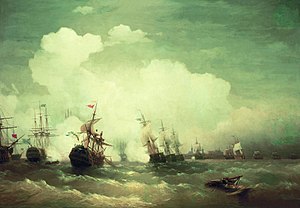Battle of Reval
| Battle of Reval | |||||||
|---|---|---|---|---|---|---|---|
| Part of the Russo-Swedish War (1788–90) | |||||||
 The Battle of Reval by Aivazovsky, Oil on Canvas. |
|||||||
|
|||||||
| Belligerents | |||||||
|
|
|
||||||
| Commanders and leaders | |||||||
| Prince Karl, Duke of Södermanland | Vasili Chichagov | ||||||
| Strength | |||||||
| 22 ships of the line 4 frigates |
9 ships of the line 5 frigates |
||||||
| Casualties and losses | |||||||
| 51 killed 81 wounded 250 captured 2 ships of the line |
8 killed 27 wounded |
||||||
The naval Battle of Reval or took place on 13 May 1790 (2 May OS) during the Russo-Swedish War (1788-1790), off the port of Reval (now Tallinn, Estonia).
Undaunted by the Swedish defeats and failures during 1789, the Swedish king, Gustav III sent the battlefleet under his brother Prince Karl, Duke of Södermanland, to eliminate Admiral Chichagov's Russian squadron, which had wintered in the harbour at Reval.
General-Admiral Duke Karl approached Reval with 26 ships of the line and large frigates mounting a combined 1,680 cannon. Chichagov, preparing to meet the enemy in the harbour, formed a battle line made up of 9 ships of the line and the frigate Venus.
The Russian fleet (9 ships of the line, 5 frigates) was anchored in a line going from Reval harbour towards the Viimsi (Wims) peninsula. The first line consisted of nine ships of the line and frigates (the 100-gun battleships Rostislav and Saratov, 74-gun Kir Ioann, Mstislav, Sv. Yelena and Yaroslav, 66-gun Pobedonosets, Boleslav and Izyaslav and the 40-gun frigate Venus). In the second line, four frigates - Podrazhislav (32 guns), Slava (32), Nadezhda Blagopoluchiya (32) and Pryamislav (36). Two bomb-vessels were deployed on the flanks. The third line was composed of seven launches.
The Swedish fleet under the command of General-Admiral Duke Karl of Södermanland consisted of 22 ships of the line, four frigates and four smaller vessels. It entered the harbour and started passing by the anchored Russian ships.
Due to strong winds and inaccurate aiming, most Swedish projectiles ricocheted past their targets, while the Russian ships that were anchored within the protected area of the harbour were able to use their guns much more effectively. The ship of the Swedish General-Admiral, which could not be brought into the wind due to a rigging problem, was forced to drift towards Rostislav and received major damage from grapeshot. The 64-gun battleship Prins Karl, fifteenth the Swedish line, lost her rudder to Russian fire and had to strike her colours.
...
Wikipedia
